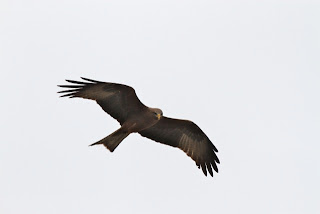Because we arrived so late the night before, we did not meet for breakfast until 8 AM. It was a large buffet with all kinds of pastries, potatoes, sausage, bacon, eggs, fruit, fruit juices, yogurt, cereal and more. We headed out before 9 feeling quite full from all the food choices we had tried. We stopped to walk along the beach, and immediately began to find new trip birds like Fischer's lovebird, and coastal cisticola. As we walked back to the landcruiser Bob took a photo of some local fisherman sitting under a concrete dock.
Our morning focus was to go to the mouth of the Sabaki River, but enroute we stopped at one small pond to check out the lily pads for African pygmy geese. There were none of them, but we added several new trip birds including African jacana, mangrove kingfisher, violet breasted sunbird, and golden palm weaver (photo taken by Bob). The weavers are another very large family of birds that we regularly saw throughout the trip.
The tide was low when we arrived at the river, and we were able to scope the mudflats for birds. We saw greater and lesser sand plovers; sanderlings; common greenshanks; black bellied, three banded and common ringed plovers; Eurasian curlews; whimbrels; common, terek and curlew sandpipers; and the white-fronted plover in the photo below taken by Bob.
We had 2 Senegal lapwings fly over, and upwards of 30 Madagascar pratincoles pass thru while we were scoping the river (photo just below taken by Bob).
We could see lots of gulls and terns further out by the river mouth, so we took a looping route thru the sand dunes where we had 4 northern carmine bee-eaters fly over as they migrated south. We flushed a few African pipits, and a black crowned tchagra. The African reed warbler just below responded to a tape (photo taken by Bob--click on any photo to enlarge).
A pair of yellow-billed storks appeared out on the edge of the dunes. The walk out to the river mouth took about 30 minutes, but fortunately it was fairly overcast and there was a nice breeze, so we did
not get fried by the sun.
Once we made it out to the river mouth, we did see roseate, common, great and lesser crested terns; sooty, and Heuglin's gulls (photo taken by Bob). Bob and I began to work our way back upriver so we missed seeing a pair of Saunder's terns picked up by Stu and Brian.
After about 3 hours of working the river area, we were getting pretty hungry again, so we drove about 45 minutes to Mida Creek. Enroute we picked up a zanzibar bishop (photo taken by Bob). The ranger at the creek told us that the day before they had seen a greater frigatebird which made Brian salivate since he had not yet seen one in Kenya.
The tide was far out at Mida Creek, but we still got good looks at several water birds including the crab plover just below (photo taken by Bob).
Our second stork species of the day was the wooly-necked in the photo just below.
With the tide out, we were able to see 1000's of snails working their way slowly across the sand.
We saw 3 more northern carmine bee-eaters migrate past, and a yellow-billed kite was circling the creek area in search of food (photo taken by Bob).
About 4 PM we climbed back into the landcruiser to make the 30 minute drive to the Sokoke forest where we met David, a local guide who has been birding in the forest for 40 years. He took us to some fields on the edge of the forest where we saw lots of Ethiopian swallows (photo just below taken by Bob).
One of our target birds was the Malindi pipit that was feeding in a cultivated field (photo just below taken by Bob). We also saw our first yellow-throated longclaw of the trip.
As dusk was approaching, David took us into the forest to look for owls and nightjars. First he found the Sokoke scops owl on its roost which was just 6 feet off the ground (photo taken by Bob). Then we called in an African barred owlet but none of our photos were successful. Next up was the fiery-necked nightjar that also eluded our cameras. Finally we attracted 3 African wood-owls, but we never got good looks at them either.
After working unsuccessfully for at least 30 minutes to get the wood-owl to fully show itself, it was time to head back to Malindi. We met for dinner at 8:30, and were greeted by another large buffet meal which was probably the best so far on our trip. We did the bird list update after eating, and found that we had added almost 50 new trip birds for the day. Tomorrow we would be spending most of the day in Sokoke forest. Stay tuned!
Subscribe to:
Post Comments (Atom)




















No comments:
Post a Comment